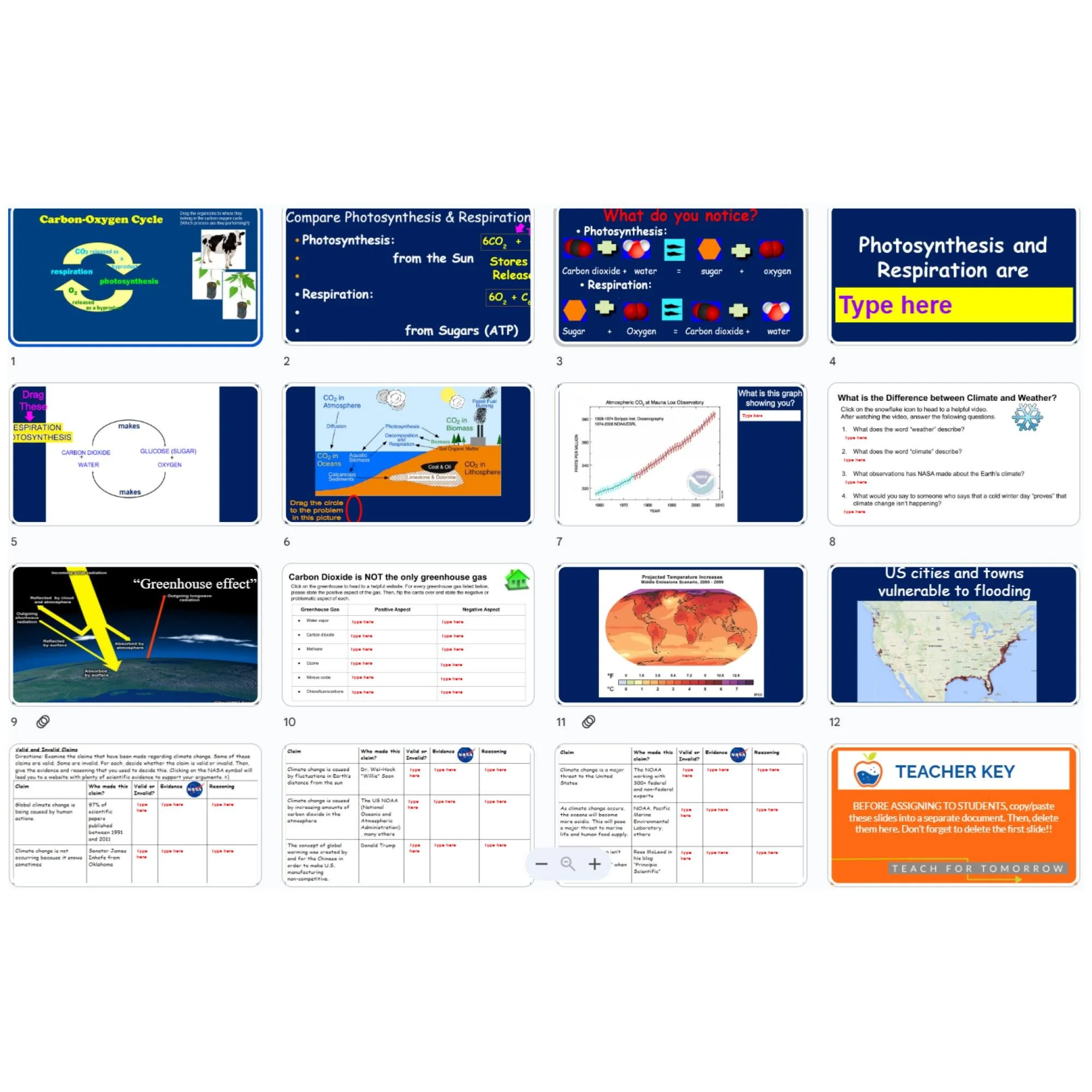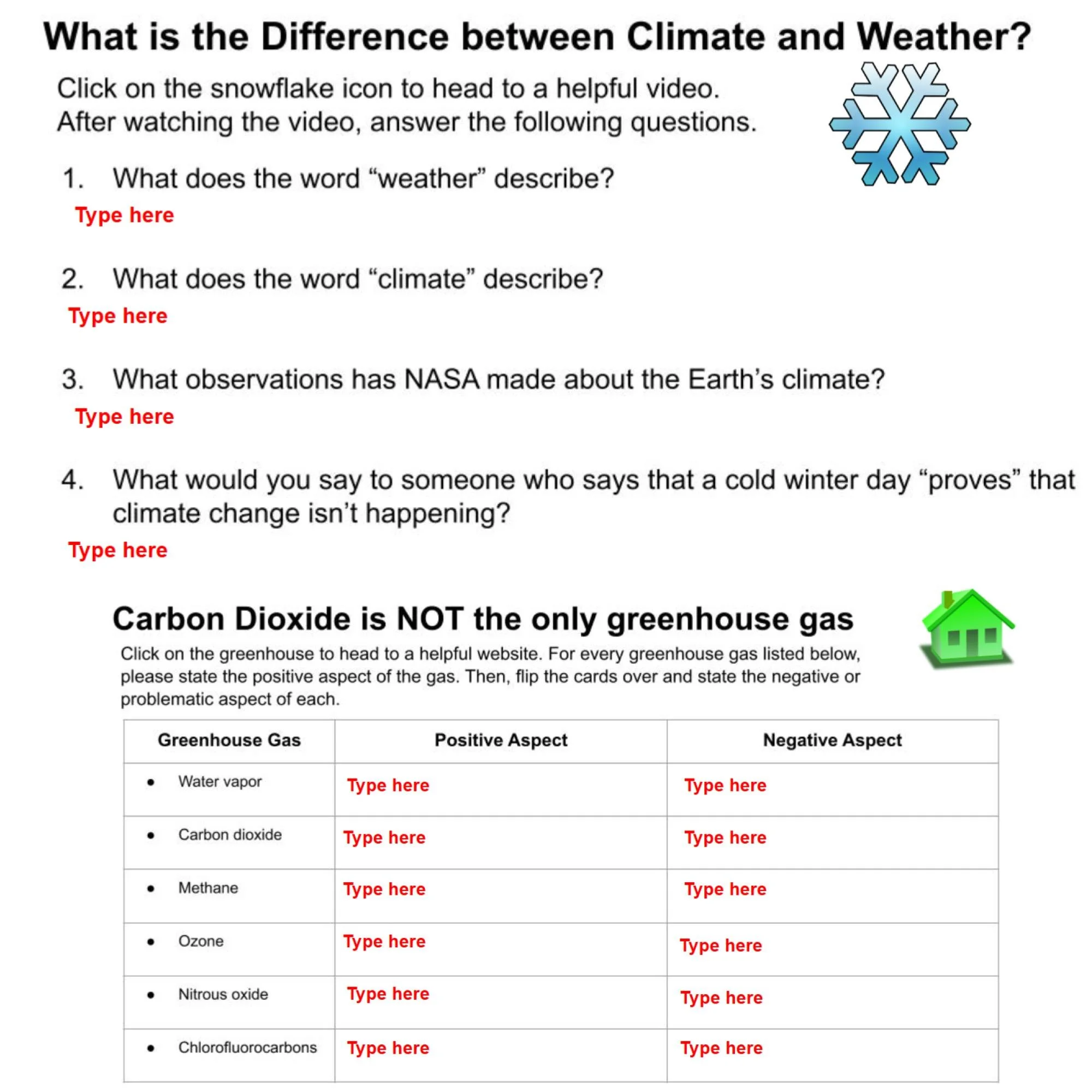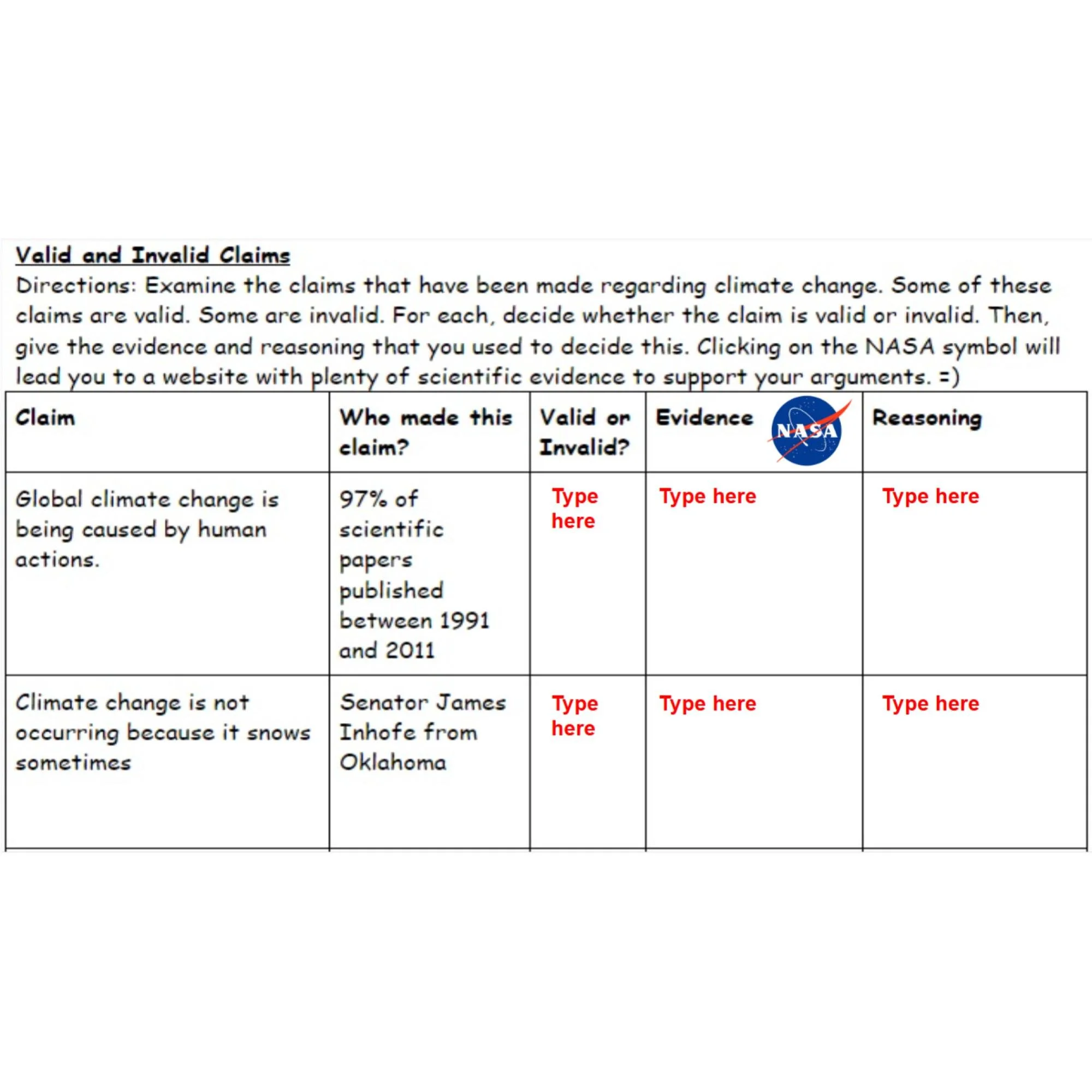



Climate Change
This seamlessly designed Google Slides lesson offers an engaging digital learning experience, allowing students to delve into the intricate workings of the carbon-oxygen cycle. The interactive format guides students through a powerful journey of learning and discovery.
Beginning with an informative introduction to the carbon-oxygen cycle, students take an active role in completing interactive notes by placing missing components on the slides. This hands-on approach fosters a deeper understanding of this critical ecological process.
As the lesson progresses, students confront the vital issue of human impact on the carbon-oxygen cycle through the burning of fossil fuels. They gain insights from a concise video distinguishing between weather and climate. A linked website serves as a gateway to further exploration, offering a deeper dive into the major greenhouse gases driving climate change.
To encourage critical thinking and informed decision-making, students examine eight diverse claims regarding climate change. Armed with their newfound knowledge and a linked NASA climate change resource, they assess the validity of each claim. Students provide evidence and reasoned explanations for their choices, honing their analytical skills.
For educators seeking to tailor the lesson to different proficiency levels, alternate, higher-level resources are readily accessible. The flexibility ensures that the material aligns perfectly with the needs of the students.
Elevate your science curriculum with this comprehensive lesson, empowering students to comprehend the intricacies of the carbon-oxygen cycle and climate change. Order now and equip your students with the knowledge and critical thinking skills needed to address one of the most pressing issues of our time.
Grade & Course Recommendation:
Middle School: Grades 7–8 environmental science or Earth science courses.
High School: Grades 9–10 biology or environmental systems unit on ecosystems and human impact.
Cross-Curricular Connections:
ELA Integration: Argumentative writing and evidence-based reasoning from data sources.
Math Integration: Interpreting graphs showing temperature or CO₂ trends.
Social Studies Integration: Links to policy, economics, and sustainability discussions.
Daily slide + literacy - based exit ticket included with purchase
Join the Lesson Laboratory and Teach for Tomorrow!
NGSS – Middle School (MS)
MS-ESS3-5: Ask questions to clarify evidence of the factors that have caused the rise in global temperatures over the past century.
MS-ESS3-3: Apply scientific principles to design a method for monitoring and minimizing human impact on the environment.
MS-ESS3-4: Construct an argument supported by evidence for how increases in human population and per-capita consumption of natural resources impact Earth’s systems.
Science & Engineering Practices: Analyzing and interpreting data; Engaging in argument from evidence.
Crosscutting Concepts: Cause and effect; Stability and change.
NGSS – High School (HS)
HS-ESS3-5: Analyze geoscience data and the results from global climate models to make an evidence-based forecast of the current rate of global or regional climate change and associated future impacts to Earth’s systems.
HS-ESS3-6: Use a computational representation to illustrate the relationships among Earth systems and how human activity is significantly altering those systems.
HS-ESS3-1: Construct an explanation based on evidence for how the availability of natural resources, natural hazards, and changes in climate have influenced human activity.
Science & Engineering Practices: Analyzing data; Constructing explanations; Using computational thinking.
Crosscutting Concepts: Stability and change; Systems and system models.
Common Core Alignment
CCSS.ELA-LITERACY.RST.6-8.1 / RST.9-10.1: Cite specific evidence to support analysis of scientific data or text.
CCSS.ELA-LITERACY.RST.6-8.7 / RST.9-10.7: Integrate data from graphs, models, and text (connection: temperature change data or CO₂ trends).
CCSS.ELA-LITERACY.WHST.6-8.1 / WHST.9-10.1: Write arguments supported by evidence about human impact on climate.
This seamlessly designed Google Slides lesson offers an engaging digital learning experience, allowing students to delve into the intricate workings of the carbon-oxygen cycle. The interactive format guides students through a powerful journey of learning and discovery.
Beginning with an informative introduction to the carbon-oxygen cycle, students take an active role in completing interactive notes by placing missing components on the slides. This hands-on approach fosters a deeper understanding of this critical ecological process.
As the lesson progresses, students confront the vital issue of human impact on the carbon-oxygen cycle through the burning of fossil fuels. They gain insights from a concise video distinguishing between weather and climate. A linked website serves as a gateway to further exploration, offering a deeper dive into the major greenhouse gases driving climate change.
To encourage critical thinking and informed decision-making, students examine eight diverse claims regarding climate change. Armed with their newfound knowledge and a linked NASA climate change resource, they assess the validity of each claim. Students provide evidence and reasoned explanations for their choices, honing their analytical skills.
For educators seeking to tailor the lesson to different proficiency levels, alternate, higher-level resources are readily accessible. The flexibility ensures that the material aligns perfectly with the needs of the students.
Elevate your science curriculum with this comprehensive lesson, empowering students to comprehend the intricacies of the carbon-oxygen cycle and climate change. Order now and equip your students with the knowledge and critical thinking skills needed to address one of the most pressing issues of our time.
Grade & Course Recommendation:
Middle School: Grades 7–8 environmental science or Earth science courses.
High School: Grades 9–10 biology or environmental systems unit on ecosystems and human impact.
Cross-Curricular Connections:
ELA Integration: Argumentative writing and evidence-based reasoning from data sources.
Math Integration: Interpreting graphs showing temperature or CO₂ trends.
Social Studies Integration: Links to policy, economics, and sustainability discussions.
Daily slide + literacy - based exit ticket included with purchase
Join the Lesson Laboratory and Teach for Tomorrow!
NGSS – Middle School (MS)
MS-ESS3-5: Ask questions to clarify evidence of the factors that have caused the rise in global temperatures over the past century.
MS-ESS3-3: Apply scientific principles to design a method for monitoring and minimizing human impact on the environment.
MS-ESS3-4: Construct an argument supported by evidence for how increases in human population and per-capita consumption of natural resources impact Earth’s systems.
Science & Engineering Practices: Analyzing and interpreting data; Engaging in argument from evidence.
Crosscutting Concepts: Cause and effect; Stability and change.
NGSS – High School (HS)
HS-ESS3-5: Analyze geoscience data and the results from global climate models to make an evidence-based forecast of the current rate of global or regional climate change and associated future impacts to Earth’s systems.
HS-ESS3-6: Use a computational representation to illustrate the relationships among Earth systems and how human activity is significantly altering those systems.
HS-ESS3-1: Construct an explanation based on evidence for how the availability of natural resources, natural hazards, and changes in climate have influenced human activity.
Science & Engineering Practices: Analyzing data; Constructing explanations; Using computational thinking.
Crosscutting Concepts: Stability and change; Systems and system models.
Common Core Alignment
CCSS.ELA-LITERACY.RST.6-8.1 / RST.9-10.1: Cite specific evidence to support analysis of scientific data or text.
CCSS.ELA-LITERACY.RST.6-8.7 / RST.9-10.7: Integrate data from graphs, models, and text (connection: temperature change data or CO₂ trends).
CCSS.ELA-LITERACY.WHST.6-8.1 / WHST.9-10.1: Write arguments supported by evidence about human impact on climate.